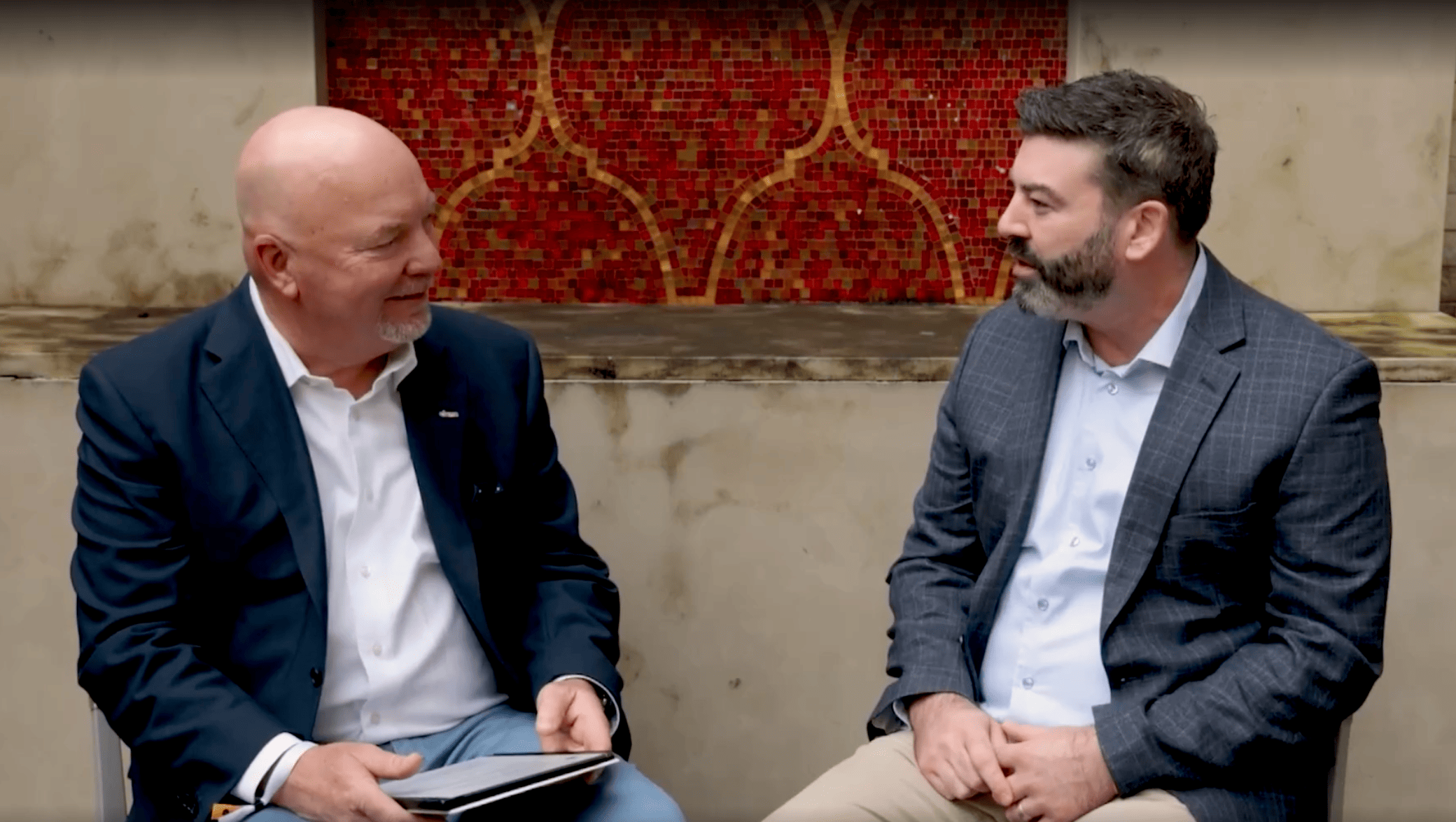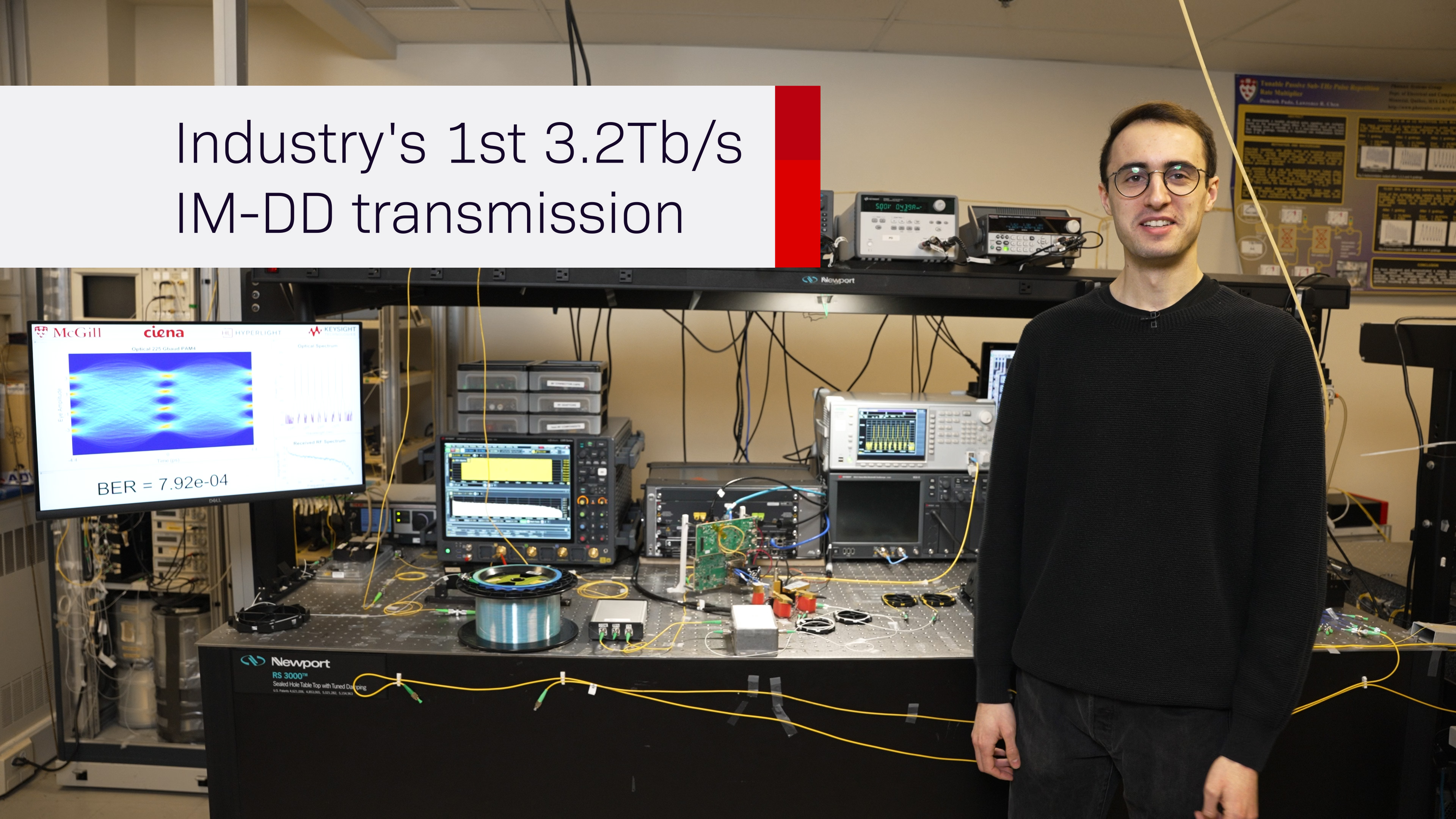Coherent optical turns 10: Here’s how it was made
This year's OFC 2018 Conference in San Diego will represent a bit of a milestone for the optical industry. It was ten years ago this week, at OFC/NFOEC on March 12, 2008, that digital coherent optical technology was officially unveiled to the world.
Coherent optical is a truly revolutionary creation that can almost magically transform old and overburdened fiber networks into superhighways of data. Service providers are now using it as the de-facto industry standard as they upgrade their networks to speeds of 100G, 200G and now even 400G.
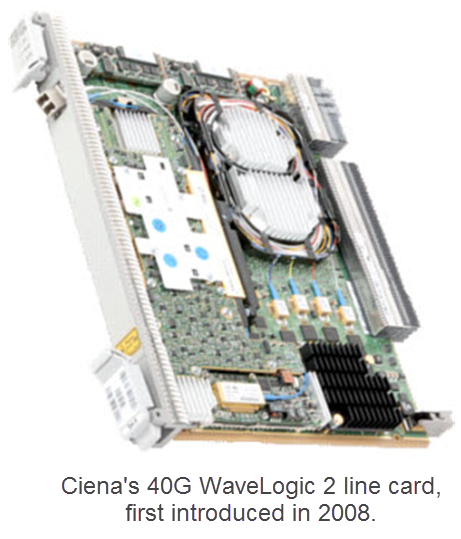 But back in 2008, many in the industry had serious doubts that commercializing coherent
fiber optic transport was even possible, much less the future of optical communications. That left a team of Ciena
engineers to defy the naysayers and hold the torch of innovation.
But back in 2008, many in the industry had serious doubts that commercializing coherent
fiber optic transport was even possible, much less the future of optical communications. That left a team of Ciena
engineers to defy the naysayers and hold the torch of innovation.
This is the story of how over 100 people in Ciena's R&D labs - including Ciena’s main R&D facility in Ottawa – pulled together an impressive collection of technology innovations that created a completely new way of transporting data over fiber, and in the process helped change the direction of the entire optical networking industry.
A Painful Experience
To fully appreciate the impact that coherent optical technology has had on the telecom industry, you need to understand the barriers that optical vendors ran into as they looked to develop the next step in transport past 10G – and that story begins back in the go-go dot-com days of the late 1990s.
It was the Fall of 1999, and over 175,000 attendees had descended on Geneva, Switzerland, for Telecom 99, the ‘Super Bowl’ of industry trade shows hosted by the ITU. The optical industry was in boom times, as network operators worldwide were scrambling to deploy new 10G fiber networks in an effort to cash in on the seemingly endless demand for bandwidth associated with the dot-com era.
A team of engineers at Nortel had spent many weeks putting the finishing touches on a new optical transport demo unveiled on the company’s booth at Telecom 99. The demo was an industry-first – transmitting 80 Gbps of data over a single wavelength of light across a span of 480 kilometers from Geneva to Paris – and it caught the attention of the entire industry.
Publicly, the team was all smiles. It was an amazing feat of technical leadership and engineering know-how. But behind the scenes, the atmosphere was more subdued.
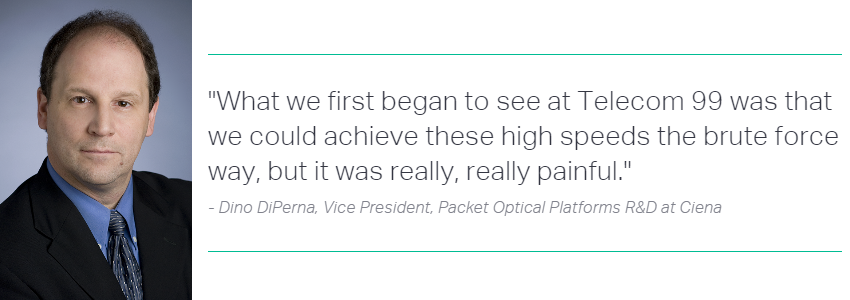
"What we first began to see at Telecom 99 was that we could achieve these high speeds the brute force way, but it was really, really painful," said Dino DiPerna in an interview. Dino, along with many in his team, were brought on by Ciena as part of the company’s 2010 acquisition of Nortel’s optical business. He now serves as Ciena’s Vice President of Packet-Optical Platforms R&D and is based in Ottawa.
By ‘brute force’ Dino is referring to the traditional time-division multiplexing (TDM) method that had been used until then to speed up optical transmission – basically turning the light on and off at increasingly faster speeds (also called the baud or symbol rate). "But once you start pushing past 10 billion times per second, you begin running into significant problems," said DiPerna.
These same problems were also being felt with the development of Ciena’s next big optical endeavor. Dubbed "Project Equinox," the R&D team in Ottawa was working on commercializing a 40G optical transport product. Like the demo at Telecom Geneva, it achieved faster transmission speeds by speeding up the baud – and that turned out to be a very complex undertaking.
The Limits of Light
Those complexities had to do with the underlying boundaries of what you can do with light. The fundamental issue at hand was the natural spread and propagation of light as it travels along the fiber – created by two phenomenon called chromatic dispersion and polarization mode dispersion, or PMD. As you push past 10G speeds, the tolerance to chromatic dispersion goes down with the square of the baud. Due to PMD and noise from optical amplifiers, a 40 Gbaud stream will lose at least 75% of its reach compared to a 10 Gbaud stream.
This reach limitation had two consequences. First, it meant adding more costly regenerators to the network. Second, it meant that the underlying fiber plant required a more expensive, high-quality fiber to operate properly at 40G transmission speeds.
In spite of these challenges, there was a willing audience for this type of innovation. Even with the expense of high-quality fiber, adaptive optical compensators, and shorter spans, the total cost-per-bit of transport could be reduced versus the day’s 10G technology, and more bandwidth at a lower cost was all network operators cared about. That was, of course, until the bottom fell out of the optical transport market.
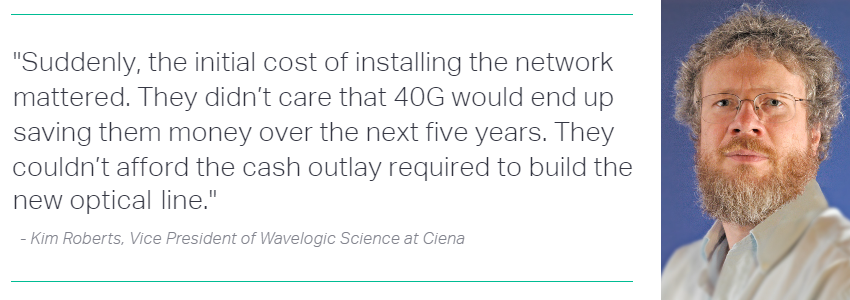
The Death of Demand
In 2001, the huge optical boom came to a crashing end. Network operators had drastically overbuilt global fiber capacity during the dot-com bubble, and it would be years before spending on optical transport equipment would fully rebound. The demands coming from network operators changed in an instant for optical equipment vendors.
"The financial aspects of the optical industry changed in 2001. Before that, the only cost consideration was total-cost-per-bit," said Kim Roberts, Vice President of Wavelogic Science at Ciena. Roberts holds over 150 patents and was recently awarded the recognition of IEEE Fellow for his contributions to coherent optical communications. "Suddenly, the initial cost of installing the network mattered. They didn’t care that 40G would end up saving them money over the next five years. They couldn’t afford the cash outlay required to build the new optical line."
With new network builds no longer on the horizon, Dino and his team knew that a completely new direction was needed.
"It was no longer realistic to go to a customer with a solution that asked them to lay down a completely new fiber network," said DiPerna. "Our development team had a lively debate over the future of our 40G program that lasted for several months. Eventually, we came to the realization that our path to 40G in 2001 was not a realistic solution for our customers, and that fresh thinking was needed."
"Our development team had a lively debate over the future of our 40G program that lasted for several months. Eventually, we came to the realization that our path to 40G in 2001 was not a realistic solution for our customers, and that fresh thinking was needed."
Reinventing Optical Transport
That fresh thinking came in the form of figuring out how to provide dramatically lower-cost, higher-capacity transport without the requirement for new fiber. To take on this colossal challenge, Dino and Kim worked with other members of the core team to pull together what they called a “synergistic stew of experts” from all across the company.
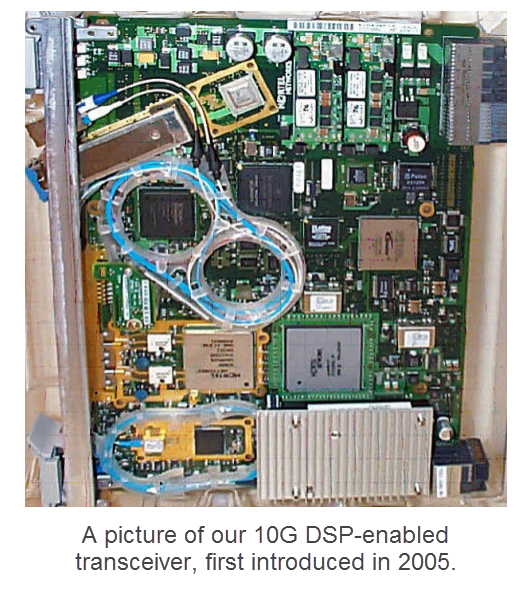 The team included engineers from the company’s
high-capacity microwave development group who were experts at digital communications, optical propagation and
devices experts, and people from the high speed circuit design group.
The team included engineers from the company’s
high-capacity microwave development group who were experts at digital communications, optical propagation and
devices experts, and people from the high speed circuit design group.
What the team produced was not so much of a single change in optical transmission but an entire series of new optical transport concepts and inventions that together enabled what we know today as coherent optical transport.
The first step along this path was the unveiling of a new 10G transmit-end chip at SuperComm 2005 that had the ability to digitally compensate for chromatic dispersion, using digital signal processing or DSP.
"That first chip was the birth of what we now call WaveLogic, it was the first generation of DSP-assisted electro-optics," said DiPerna. "Transmit digital compensation allowed the use of a traditional receiver design without the need for the customer to worry about dispersion. We knew we were on a path that represented the future of optical transport."
"DSP was important for 10G networks because it allowed for a much simpler and more flexible network design by eliminating the need for in-line dispersion compensation," said Roberts. "While it didn’t enjoy the notoriety that our coherent 40G received, it was a big scientific and mindset differentiator that got us started towards coherent products."
In fact, even as the new 10G chip was being unveiled at SuperComm 2005, the team was already busy at work on the company’s next generation optical receiver chip, and it would become the world’s first digital coherent optical solution.
But to achieve coherent 40G required a revolutionary set of new technologies and innovations that could all fit together in perfect complement.
"That 40G coherent project was a great example of a diverse team coming together to solve a problem from all angles," said DiPerna. "Individually, each technology advancement was impressive – whether it be the advanced DSP, the coherent receiver using DP QPSK, the analog-to-digital converter development, or a dozen other parts to the puzzle."
A Miniaturized Marvel
One of those parts to the coherent 40G puzzle was the analog-to-digital converter. To support the level of digital signal processing required to correct for chromatic dispersion and PMD at 40G speeds, the team needed to shrink the analog-to-digital converter (ADC) so that it could be embedded into a custom chip (an ASIC) that could fit on an optical line card. But at the time, high speed ADCs were expensive and power-hungry stand alone devices.
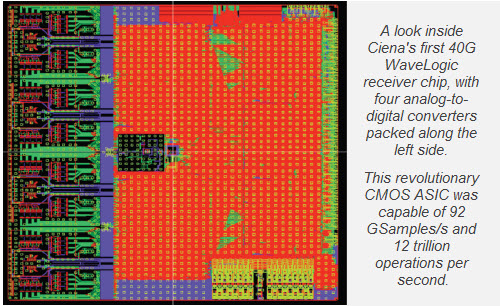
"Nobody knew if we could miniaturize an ADC that could provide that kind of performance and power efficiency," said DiPerna. "It required a completely new type of chip that had really never even been considered, much less designed and deployed."
That’s where Peter Schvan entered the picture. Schvan and his team designed an ADC test chip, code named the “A-chip”. It was small enough (and just as importantly energy efficient enough) so that four of these ADC chips could be part of a custom CMOS ASIC only about 15 mm square. In 2006, the A-chip was ready for testing.
“That was one of the seminal moments in the development of coherent,” said Peter Schvan in an interview. Schvan is now Ciena’s Director of Hardware Engineering and based in Ottawa. “No matter how carefully you design it, the complexity of this mixed mode ASIC is such that no simulation tool can predict everything. You have to rely on your experience to predict the critical blocks and design them to a higher performance than needed to guarantee success. We couldn’t afford a second iteration of the mixed digital and analog ASIC – it had to work the first time, and it did.”
“When Peter’s team delivered that test chip and it worked in the overall 40G coherent system, that really caught customers' attention,” said DiPerna. “For many that were closely following the project, the idea of a coherent system went from theory to reality at that moment.”
This new bleeding edge ADC was just one of the innovations the team was developing. The team’s efforts combined the world’s first optical coherent receiver to use the power of digital signal processing with the innovative use of wireless-inspired modulation schemes like DP QPSK and high performance forward error correction (FEC).
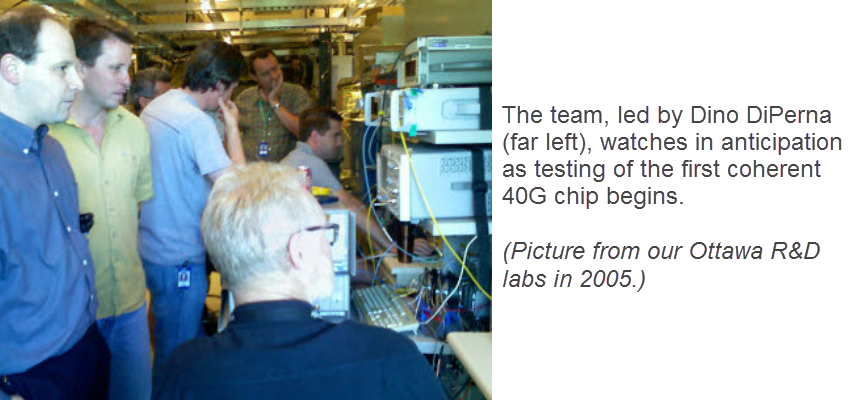
Lighting It Up
Even with the team’s progress across a host of individual technologies, there was still much work to be done to commercialize a complete coherent 40G solution. And not everyone was convinced it could be done.
“We were definitely not following the consensus view to 40G,” said DiPerna. “There were many skeptics in the industry that thought this idea of coherent networking was too expensive and complex to be widely deployed in commercial networks. The reality was that this was an incredibly complex technology to engineer and build, but the result was a new level of optical simplicity and cost-per-bit efficiency for the end customer.”
That became clear as the development team moved coherent technology away from being a series of concept demos in the lab and closer to an actual deployable solution within the company’s 6500 packet-optical platform.
“We brought customers into the lab to see our 40G demo, and they were amazed,” said DiPerna. “In just a matter of minutes, they’d go from doubting and questioning the concept to asking us when they could get their hands on it. It was a really exciting time to see the reactions our customers had when they realized the impact that coherent could have on their networks.”
On March 12, 2008, the industry’s first coherent 40G optical transport solution was officially unveiled to the world, along with the announcement of the solution’s first two customers. By late 2009, that same coherent chip would be powering the first ever live 100G coherent network, a 893km link between Paris and Frankfurt on Verizon’s network.
Coherent For The Future
Today, coherent optical technology is the foundation of the industry’s global deployment of transport speeds at 100G, 200G, and now even 400G, and Ciena is at the forefront of those efforts (see 400G Industry Adoption is Taking Off). In fact, many of the same teammates that began the coherent journey still innovate in the Ciena Ottawa R&D lab.
The imagination and dedication of the entire development team, in the face of a massive market downturn and an industry full of skeptics, is in hindsight something that many of us may not be able to fully appreciate.

The Ciena team in
Ottawa celebrates commercial availability of WaveLogic 3 back in 2013, which took a new generation of 100G
coherent speeds mainstream in the optical market.
“Our team was faced with everything from technology hurdles to industry skeptics to a historic market downturn,” said DiPerna. “But we were all driven by the idea of coherent optical that made us think completely out of the box to overcome technical issues our competitors thought were unsolvable. It pushed the team and they responded with a ‘never take no for an answer’ attitude. It was, and still is, a privilege being a part of that team.”
The work of that team hasn’t stopped. In 2013, the team unveiled WaveLogic 3, featuring the industry's first integrated digital signal processing in the transmitter (Tx DSP). Just last year, the team unveiled the latest generation of WaveLogic with Wavelogic Ai, which features programmable bandwidth from 100G to 400G and the industry's first single carrier 400G solution. And it’s all still possible over the same old fiber plant that challenged the team those many years ago.
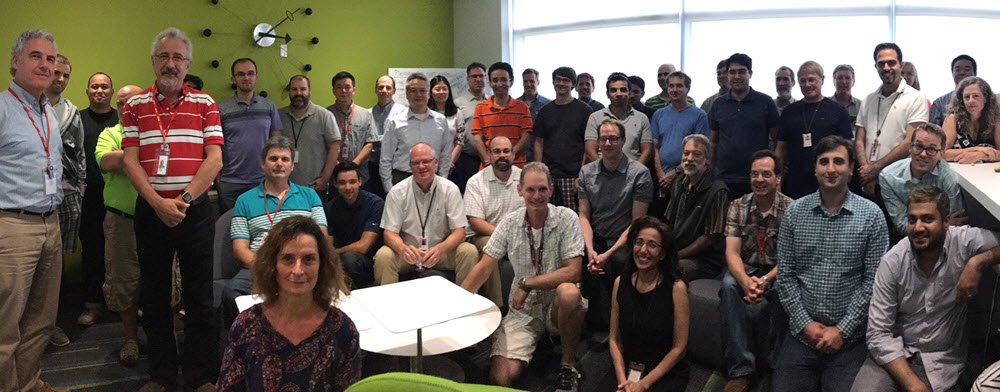
The Ciena team gathers, this time in 2017, to celebrate the availability of WaveLogic Ai, the latest generation coherent optical chipset and the industry's first single carrier 400G solution.
----------------------------------------
This article was originally published in 2013 at the 5-year anniversary of the unveiling of coherent optical technology, and was updated for this 10-year anniversary post. A special thanks goes out to the many people in the Ciena team that helped with the creation of this post, including Helen Xenos, Dino DiPerna, Kim Roberts, Peter Schvan, Roger Carroll, Charles Laperle and Bruce Beggs.





